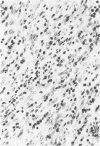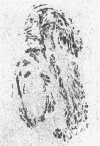Abstract
Five cases of inflammatory pseudotumor (IPT) of the lymph node were investigated by means of light microscopy and immunohistochemistry to elucidate its cellular composition. The IPT is composed of a proliferation of spindle cells, inflammatory cells, and small vessels, forming high and poor cellular areas. Many spindle cells correspond to activated histiocytes as they coexpress vimentin and macrophage-associated markers; they are intermingled with vimentin-positive fibroblasts and variable numbers of vimentin- and actin-positive myofibroblasts. This mixed-cell proliferation invades and/or destroys medium- and large-sized vessels in all cases. This study indicates that the spindle cell proliferation, identified as histiocytic and fibroblastic in nature, represents the main component of the nodal IPT. We speculate that release of cytokines by the activated histiocytes may result in the development of the complex histopathologic aspects of this inflammatory process and, if inappropriate, may represent the underlying pathogenic mechanism.
Full text
PDF
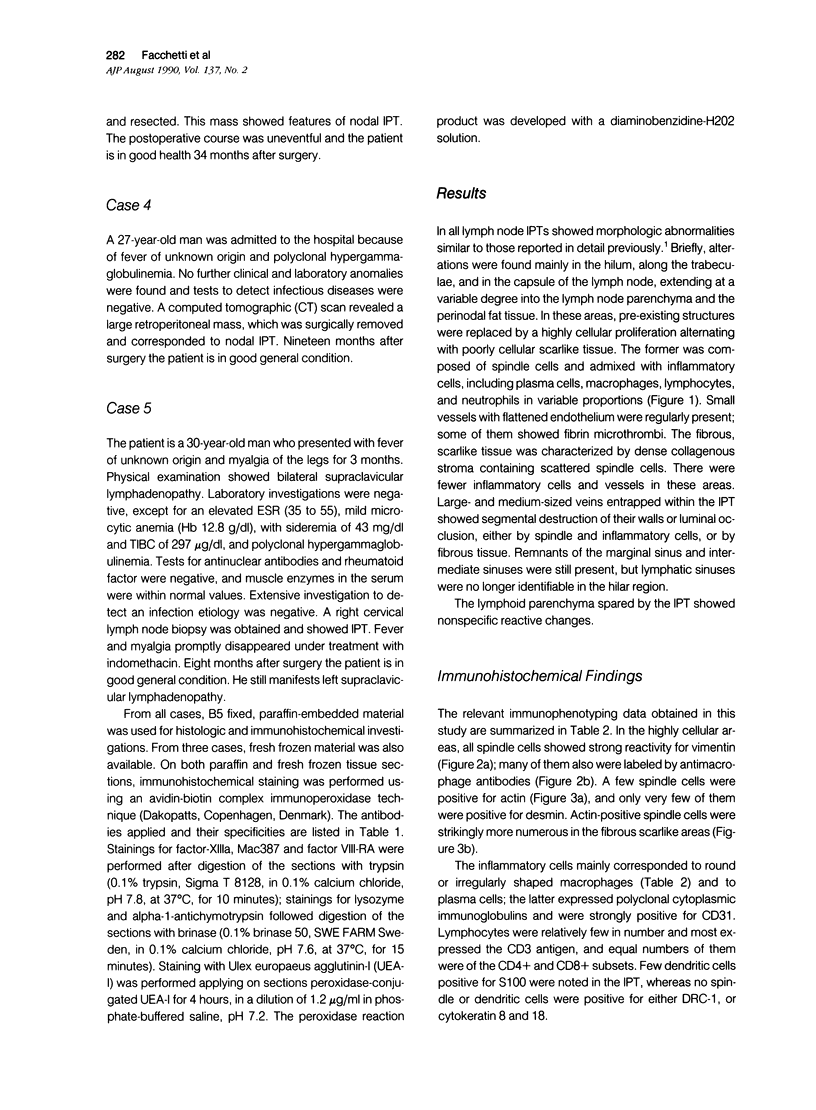

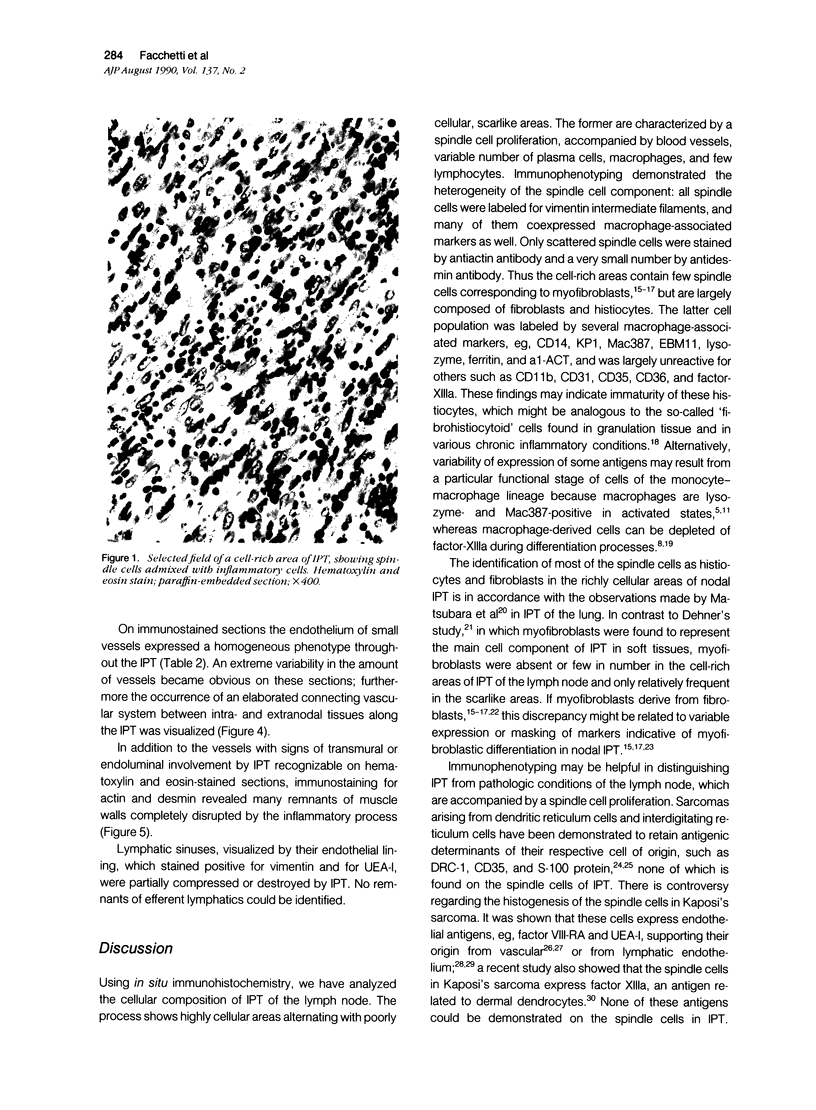


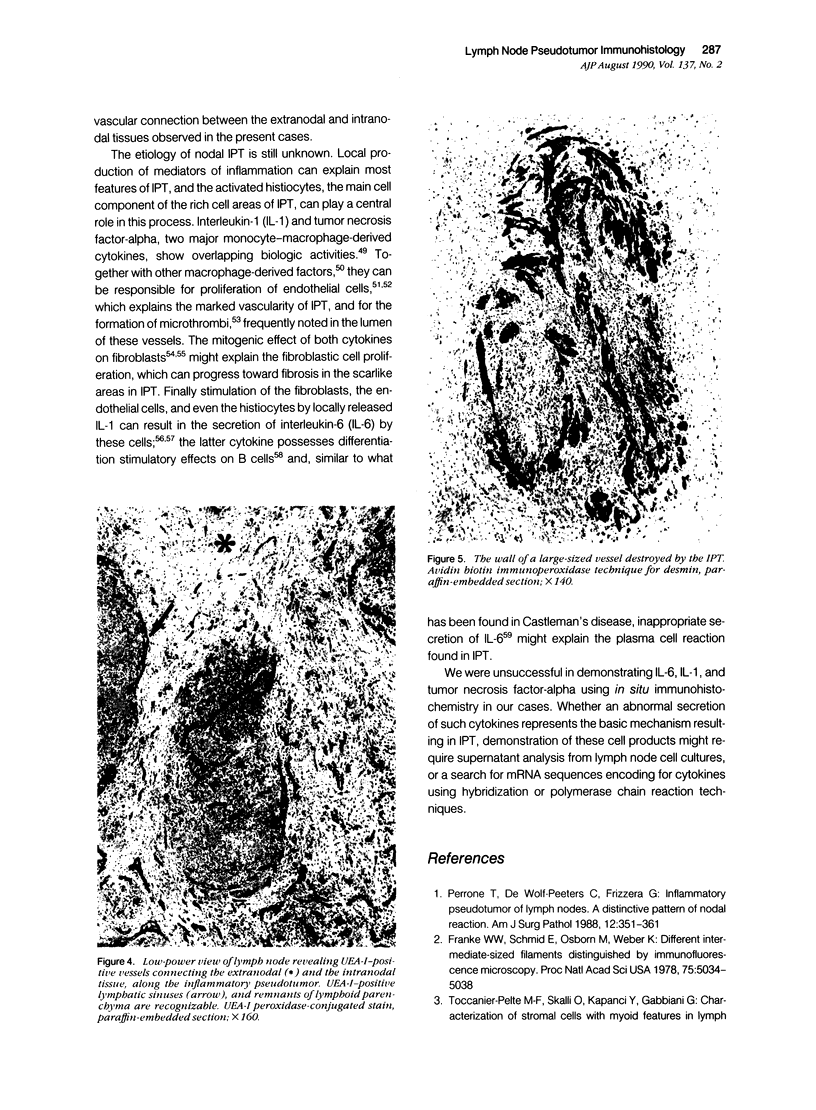
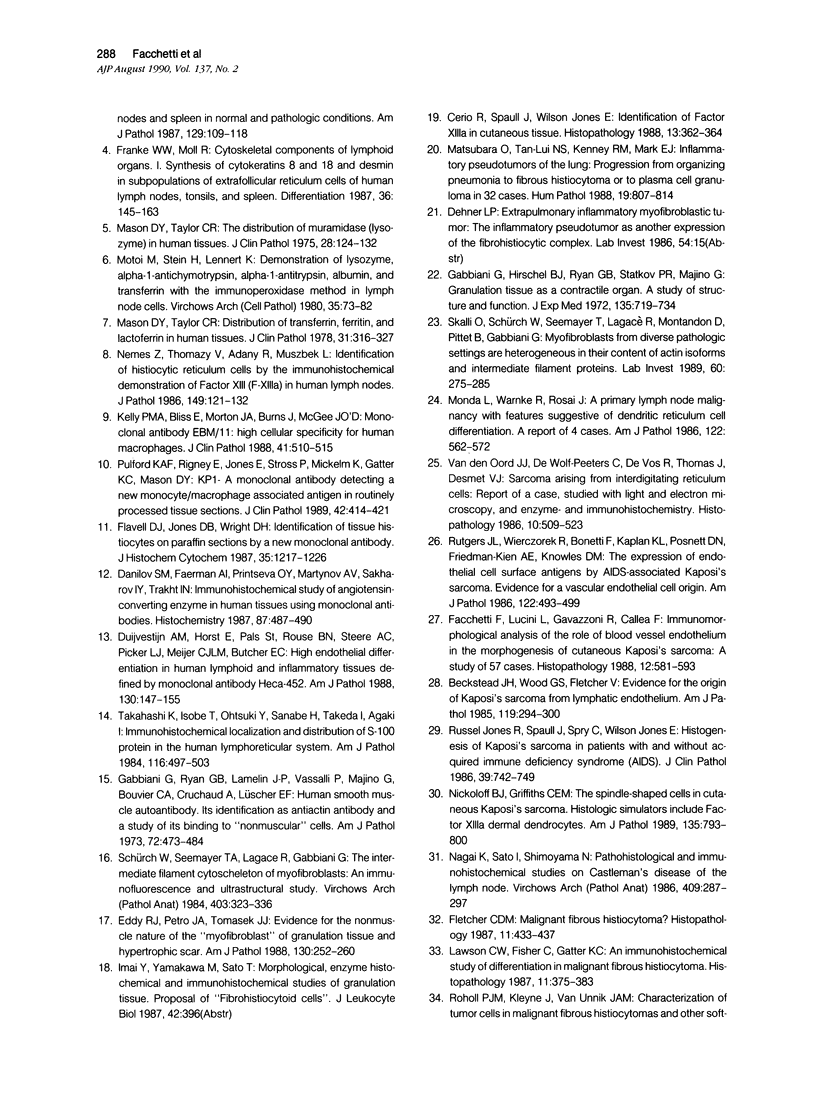

Images in this article
Selected References
These references are in PubMed. This may not be the complete list of references from this article.
- Anthony P. P., Telesinghe P. U. Inflammatory pseudotumour of the liver. J Clin Pathol. 1986 Jul;39(7):761–768. doi: 10.1136/jcp.39.7.761. [DOI] [PMC free article] [PubMed] [Google Scholar]
- Bahadori M., Liebow A. A. Plasma cell granulomas of the lung. Cancer. 1973 Jan;31(1):191–208. doi: 10.1002/1097-0142(197301)31:1<191::aid-cncr2820310127>3.0.co;2-d. [DOI] [PubMed] [Google Scholar]
- Beckstead J. H., Wood G. S., Fletcher V. Evidence for the origin of Kaposi's sarcoma from lymphatic endothelium. Am J Pathol. 1985 May;119(2):294–300. [PMC free article] [PubMed] [Google Scholar]
- Cerio R., Spaull J., Jones E. W. Identification of factor XIIIa in cutaneous tissue. Histopathology. 1988 Sep;13(3):362–364. doi: 10.1111/j.1365-2559.1988.tb02051.x. [DOI] [PubMed] [Google Scholar]
- Chen K. T. Inflammatory pseudotumor of the liver. Hum Pathol. 1984 Jul;15(7):694–696. doi: 10.1016/s0046-8177(84)80298-1. [DOI] [PubMed] [Google Scholar]
- Cybulsky M. I., Chan M. K., Movat H. Z. Acute inflammation and microthrombosis induced by endotoxin, interleukin-1, and tumor necrosis factor and their implication in gram-negative infection. Lab Invest. 1988 Apr;58(4):365–378. [PubMed] [Google Scholar]
- Danilov S. M., Faerman A. I., Printseva OYu, Martynov A. V., Sakharov IYu, Trakht I. N. Immunohistochemical study of angiotensin-converting enzyme in human tissues using monoclonal antibodies. Histochemistry. 1987;87(5):487–490. doi: 10.1007/BF00496822. [DOI] [PubMed] [Google Scholar]
- Duijvestijn A. M., Horst E., Pals S. T., Rouse B. N., Steere A. C., Picker L. J., Meijer C. J., Butcher E. C. High endothelial differentiation in human lymphoid and inflammatory tissues defined by monoclonal antibody HECA-452. Am J Pathol. 1988 Jan;130(1):147–155. [PMC free article] [PubMed] [Google Scholar]
- Eddy R. J., Petro J. A., Tomasek J. J. Evidence for the nonmuscle nature of the "myofibroblast" of granulation tissue and hypertropic scar. An immunofluorescence study. Am J Pathol. 1988 Feb;130(2):252–260. [PMC free article] [PubMed] [Google Scholar]
- Facchetti F., Lucini L., Gavazzoni R., Callea F. Immunomorphological analysis of the role of blood vessel endothelium in the morphogenesis of cutaneous Kaposi's sarcoma: a study of 57 cases. Histopathology. 1988 Jun;12(6):581–593. doi: 10.1111/j.1365-2559.1988.tb01983.x. [DOI] [PubMed] [Google Scholar]
- Flavell D. J., Jones D. B., Wright D. H. Identification of tissue histiocytes on paraffin sections by a new monoclonal antibody. J Histochem Cytochem. 1987 Nov;35(11):1217–1226. doi: 10.1177/35.11.3309045. [DOI] [PubMed] [Google Scholar]
- Fletcher C. D. Malignant fibrous histiocytoma? Histopathology. 1987 Apr;11(4):433–437. doi: 10.1111/j.1365-2559.1987.tb02648.x. [DOI] [PubMed] [Google Scholar]
- Franke W. W., Moll R. Cytoskeletal components of lymphoid organs. I. Synthesis of cytokeratins 8 and 18 and desmin in subpopulations of extrafollicular reticulum cells of human lymph nodes, tonsils, and spleen. Differentiation. 1987;36(2):145–163. doi: 10.1111/j.1432-0436.1987.tb00189.x. [DOI] [PubMed] [Google Scholar]
- Franke W. W., Schmid E., Osborn M., Weber K. Different intermediate-sized filaments distinguished by immunofluorescence microscopy. Proc Natl Acad Sci U S A. 1978 Oct;75(10):5034–5038. doi: 10.1073/pnas.75.10.5034. [DOI] [PMC free article] [PubMed] [Google Scholar]
- Gabbiani G., Hirschel B. J., Ryan G. B., Statkov P. R., Majno G. Granulation tissue as a contractile organ. A study of structure and function. J Exp Med. 1972 Apr 1;135(4):719–734. doi: 10.1084/jem.135.4.719. [DOI] [PMC free article] [PubMed] [Google Scholar]
- Gabbiani G., Ryan G. B., Lamelin J. P., Vassalli P., Majno G., Bouvier C. A., Cruchaud A., Lüscher E. F. Human smooth muscle autoantibody. Its identification as antiactin antibody and a study of its binding to "nonmuscular" cells. Am J Pathol. 1973 Sep;72(3):473–488. [PMC free article] [PubMed] [Google Scholar]
- Hirano T., Yasukawa K., Harada H., Taga T., Watanabe Y., Matsuda T., Kashiwamura S., Nakajima K., Koyama K., Iwamatsu A. Complementary DNA for a novel human interleukin (BSF-2) that induces B lymphocytes to produce immunoglobulin. Nature. 1986 Nov 6;324(6092):73–76. doi: 10.1038/324073a0. [DOI] [PubMed] [Google Scholar]
- Jones R. R., Spaull J., Spry C., Jones E. W. Histogenesis of Kaposi's sarcoma in patients with and without acquired immune deficiency syndrome (AIDS). J Clin Pathol. 1986 Jul;39(7):742–749. doi: 10.1136/jcp.39.7.742. [DOI] [PMC free article] [PubMed] [Google Scholar]
- Kelly P. M., Bliss E., Morton J. A., Burns J., McGee J. O. Monoclonal antibody EBM/11: high cellular specificity for human macrophages. J Clin Pathol. 1988 May;41(5):510–515. doi: 10.1136/jcp.41.5.510. [DOI] [PMC free article] [PubMed] [Google Scholar]
- Lawson C. W., Fisher C., Gatter K. C. An immunohistochemical study of differentiation in malignant fibrous histiocytoma. Histopathology. 1987 Apr;11(4):375–383. doi: 10.1111/j.1365-2559.1987.tb02642.x. [DOI] [PubMed] [Google Scholar]
- Le J., Vilcek J. Tumor necrosis factor and interleukin 1: cytokines with multiple overlapping biological activities. Lab Invest. 1987 Mar;56(3):234–248. [PubMed] [Google Scholar]
- Leibovich S. J., Polverini P. J., Shepard H. M., Wiseman D. M., Shively V., Nuseir N. Macrophage-induced angiogenesis is mediated by tumour necrosis factor-alpha. Nature. 1987 Oct 15;329(6140):630–632. doi: 10.1038/329630a0. [DOI] [PubMed] [Google Scholar]
- Mason D. Y., Taylor C. R. Distribution of transferrin, ferritin, and lactoferrin in human tissues. J Clin Pathol. 1978 Apr;31(4):316–327. doi: 10.1136/jcp.31.4.316. [DOI] [PMC free article] [PubMed] [Google Scholar]
- Mason D. Y., Taylor C. R. The distribution of muramidase (lysozyme) in human tissues. J Clin Pathol. 1975 Feb;28(2):124–132. doi: 10.1136/jcp.28.2.124. [DOI] [PMC free article] [PubMed] [Google Scholar]
- Matsubara O., Tan-Liu N. S., Kenney R. M., Mark E. J. Inflammatory pseudotumors of the lung: progression from organizing pneumonia to fibrous histiocytoma or to plasma cell granuloma in 32 cases. Hum Pathol. 1988 Jul;19(7):807–814. doi: 10.1016/s0046-8177(88)80264-8. [DOI] [PubMed] [Google Scholar]
- Maurer R., Schmid U., Davies J. D., Mahy N. J., Stansfeld A. G., Lukes R. J. Lymph-node infarction and malignant lymphoma: a multicentre survey of European, English and American cases. Histopathology. 1986 Jun;10(6):571–588. doi: 10.1111/j.1365-2559.1986.tb02511.x. [DOI] [PubMed] [Google Scholar]
- Monda L., Warnke R., Rosai J. A primary lymph node malignancy with features suggestive of dendritic reticulum cell differentiation. A report of 4 cases. Am J Pathol. 1986 Mar;122(3):562–572. [PMC free article] [PubMed] [Google Scholar]
- Motoi M., Stein H., Lennert K. Demonstration of lysozyme, alpha 1-antichymotrypsin, alpha 1-antitrypsin, albumin, and transferrin with the immunoperoxidase method in lymph node cells. Virchows Arch B Cell Pathol Incl Mol Pathol. 1980;35(1):73–82. doi: 10.1007/BF02889150. [DOI] [PubMed] [Google Scholar]
- Nagai K., Sato I., Shimoyama N. Pathohistological and immunohistochemical studies on Castleman's disease of the lymph node. Virchows Arch A Pathol Anat Histopathol. 1986;409(2):287–297. doi: 10.1007/BF00708335. [DOI] [PubMed] [Google Scholar]
- Nemes Z., Thomázy V., Adány R., Muszbek L. Identification of histiocytic reticulum cells by the immunohistochemical demonstration of factor XIII (F-XIIIa) in human lymph nodes. J Pathol. 1986 Jun;149(2):121–132. doi: 10.1002/path.1711490207. [DOI] [PubMed] [Google Scholar]
- Nickoloff B. J., Griffiths C. E. The spindle-shaped cells in cutaneous Kaposi's sarcoma. Histologic simulators include factor XIIIa dermal dendrocytes. Am J Pathol. 1989 Nov;135(5):793–800. [PMC free article] [PubMed] [Google Scholar]
- Ooi B. S., MacCarthy E. P., Hsu A., Ooi Y. M. Human mononuclear cell modulation of endothelial cell proliferation. J Lab Clin Med. 1983 Sep;102(3):428–433. [PubMed] [Google Scholar]
- Osogoe B., Courtice F. C. The effects of occlusion of the blood supply to the popliteal lymph node of the rabbit on the cell and protein content of the lymph and on the histology of the node. Aust J Exp Biol Med Sci. 1968 Oct;46(5):515–524. doi: 10.1038/icb.1968.159. [DOI] [PubMed] [Google Scholar]
- Perrone T., De Wolf-Peeters C., Frizzera G. Inflammatory pseudotumor of lymph nodes. A distinctive pattern of nodal reaction. Am J Surg Pathol. 1988 May;12(5):351–361. doi: 10.1097/00000478-198805000-00003. [DOI] [PubMed] [Google Scholar]
- Polverini P. J., Cotran P. S., Gimbrone M. A., Jr, Unanue E. R. Activated macrophages induce vascular proliferation. Nature. 1977 Oct 27;269(5631):804–806. doi: 10.1038/269804a0. [DOI] [PubMed] [Google Scholar]
- Pulford K. A., Rigney E. M., Micklem K. J., Jones M., Stross W. P., Gatter K. C., Mason D. Y. KP1: a new monoclonal antibody that detects a monocyte/macrophage associated antigen in routinely processed tissue sections. J Clin Pathol. 1989 Apr;42(4):414–421. doi: 10.1136/jcp.42.4.414. [DOI] [PMC free article] [PubMed] [Google Scholar]
- Rutgers J. L., Wieczorek R., Bonetti F., Kaplan K. L., Posnett D. N., Friedman-Kien A. E., Knowles D. M., 2nd The expression of endothelial cell surface antigens by AIDS-associated Kaposi's sarcoma. Evidence for a vascular endothelial cell origin. Am J Pathol. 1986 Mar;122(3):493–499. [PMC free article] [PubMed] [Google Scholar]
- Schmidt J. A., Mizel S. B., Cohen D., Green I. Interleukin 1, a potential regulator of fibroblast proliferation. J Immunol. 1982 May;128(5):2177–2182. [PubMed] [Google Scholar]
- Schürch W., Seemayer T. A., Lagacé R., Gabbiani G. The intermediate filament cytoskeleton of myofibroblasts: an immunofluorescence and ultrastructural study. Virchows Arch A Pathol Anat Histopathol. 1984;403(4):323–336. doi: 10.1007/BF00737283. [DOI] [PubMed] [Google Scholar]
- Sironi M., Breviario F., Proserpio P., Biondi A., Vecchi A., Van Damme J., Dejana E., Mantovani A. IL-1 stimulates IL-6 production in endothelial cells. J Immunol. 1989 Jan 15;142(2):549–553. [PubMed] [Google Scholar]
- Skalli O., Schürch W., Seemayer T., Lagacé R., Montandon D., Pittet B., Gabbiani G. Myofibroblasts from diverse pathologic settings are heterogeneous in their content of actin isoforms and intermediate filament proteins. Lab Invest. 1989 Feb;60(2):275–285. [PubMed] [Google Scholar]
- Someren A. "Inflammatory pseudotumor" of liver with occlusive phlebitis: report of a case in a child and review of the literature. Am J Clin Pathol. 1978 Feb;69(2):176–181. doi: 10.1093/ajcp/69.2.176. [DOI] [PubMed] [Google Scholar]
- Spencer H. The pulmonary plasma cell/histiocytoma complex. Histopathology. 1984 Nov;8(6):903–916. doi: 10.1111/j.1365-2559.1984.tb02409.x. [DOI] [PubMed] [Google Scholar]
- Sugarman B. J., Aggarwal B. B., Hass P. E., Figari I. S., Palladino M. A., Jr, Shepard H. M. Recombinant human tumor necrosis factor-alpha: effects on proliferation of normal and transformed cells in vitro. Science. 1985 Nov 22;230(4728):943–945. doi: 10.1126/science.3933111. [DOI] [PubMed] [Google Scholar]
- Suster S., Rosai J. Intranodal hemorrhagic spindle-cell tumor with "amianthoid" fibers. Report of six cases of a distinctive mesenchymal neoplasm of the inguinal region that simulates Kaposi's sarcoma. Am J Surg Pathol. 1989 May;13(5):347–357. [PubMed] [Google Scholar]
- Takahashi K., Isobe T., Ohtsuki Y., Sonobe H., Takeda I., Akagi T. Immunohistochemical localization and distribution of S-100 proteins in the human lymphoreticular system. Am J Pathol. 1984 Sep;116(3):497–503. [PMC free article] [PubMed] [Google Scholar]
- Turner R. R., Beckstead J. H., Warnke R. A., Wood G. S. Endothelial cell phenotypic diversity. In situ demonstration of immunologic and enzymatic heterogeneity that correlates with specific morphologic subtypes. Am J Clin Pathol. 1987 May;87(5):569–575. doi: 10.1093/ajcp/87.5.569. [DOI] [PubMed] [Google Scholar]
- Van Damme J., Opdenakker G., Simpson R. J., Rubira M. R., Cayphas S., Vink A., Billiau A., Van Snick J. Identification of the human 26-kD protein, interferon beta 2 (IFN-beta 2), as a B cell hybridoma/plasmacytoma growth factor induced by interleukin 1 and tumor necrosis factor. J Exp Med. 1987 Mar 1;165(3):914–919. doi: 10.1084/jem.165.3.914. [DOI] [PMC free article] [PubMed] [Google Scholar]
- Warter A., Satge D., Roeslin N. Angioinvasive plasma cell granulomas of the lung. Cancer. 1987 Feb 1;59(3):435–443. doi: 10.1002/1097-0142(19870201)59:3<435::aid-cncr2820590315>3.0.co;2-6. [DOI] [PubMed] [Google Scholar]
- Watts J. C., Sebek B. A., McHenry M. C., Esselstyn C. B., Jr Idiopathic infarction of intraabdominal lymph nodes. A cause of fever of unknown origin. Am J Clin Pathol. 1980 Nov;74(5):687–690. doi: 10.1093/ajcp/74.5.687. [DOI] [PubMed] [Google Scholar]
- Weiss S. W., Gnepp D. R., Bratthauer G. L. Palisaded myofibroblastoma. A benign mesenchymal tumor of lymph node. Am J Surg Pathol. 1989 May;13(5):341–346. [PubMed] [Google Scholar]
- Wood G. S., Beckstead J. H., Turner R. R., Hendrickson M. R., Kempson R. L., Warnke R. A. Malignant fibrous histiocytoma tumor cells resemble fibroblasts. Am J Surg Pathol. 1986 May;10(5):323–335. doi: 10.1097/00000478-198605000-00004. [DOI] [PubMed] [Google Scholar]
- Yabuhara A., Yanagisawa M., Murata T., Kawai H., Komiyama A., Akabane T., Itoh M., Ishii E., Fujimoto J., Hata J. Giant lymph node hyperplasia (Castleman's disease) with spontaneous production of high levels of B-cell differentiation factor activity. Cancer. 1989 Jan 15;63(2):260–265. doi: 10.1002/1097-0142(19890115)63:2<260::aid-cncr2820630210>3.0.co;2-y. [DOI] [PubMed] [Google Scholar]
- van den Oord J. J., de Wolf-Peeters C., de Vos R., Thomas J., Desmet V. J. Sarcoma arising from interdigitating reticulum cells: report of a case, studied with light and electron microscopy, and enzyme- and immunohistochemistry. Histopathology. 1986 May;10(5):509–523. doi: 10.1111/j.1365-2559.1986.tb02502.x. [DOI] [PubMed] [Google Scholar]



